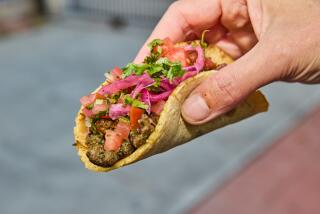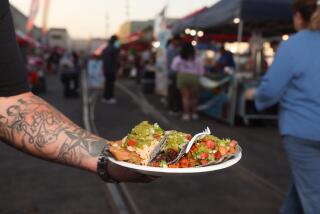Comfort Food : Ambrosia: Innocent Pleasures : Side dishes: The frothy fruit concoction has a long and highly caloric history.
Ambrosia: Ancient food of the gods--or ungodly food of the ancients? In the 6th Century BC, when the Greek poet Ibycus coined the name, it can be assumed that he had something flashier in mind than the creamy concoction enjoyed for the last century or so in the U.S.A.
Back in Olympian times, ambrosia gave whoever ate it immortality. Today, a big scoop of the deceptively fluffy stuff just moves people further along toward artery-blocking inertia.
Ambrosia has never been a brilliant eating experience. Made basically of heavily caloric sweet things--fruit, whipped cream, marshmallows and coconut--gooshed up in a big bowl, ambrosia is an anyone-can-do-it recipe that the adventurous may choose to customize with their own favorite fruits, and the casual cook can throw together with nothing more complicated than canned fruit cocktail, a container of Dream Whip and a bag of mini-marshmallows. It has no special textures to self-consciously acknowledge, and it needs no acquired taste to appreciate.
Bland? Innocuous? Certainly--and proud of it! For this en- Lite ned era, ambrosia may be a many-carbohydrated treat out of time, but it has a homey durability. Beyond trends, it is a great American security food.
When I was a young man going through my obligatory starving-in-New-York period, quarter-pound quantities of ambrosia were among the few comforts I could afford to indulge in. Inside my standard-issue Manhattan tenement, I would dump the deli-bought ambrosia into a salad bowl. This mountain of whipped cream, dappled with mandarin orange sections, flecks of coconut and the chewy sweet nothingness of mini-marshmallows (the Shmoo of the confection chain), didn’t quite make up for my lack of money or master plan, but it did manage to provide fleeting moments of solace. By the light of the TV, I would devour it, leaving the remains for the roaches. Noblesse oblige on the New York poverty line.
So ubiquitous is ambrosia in the archives of American cuisine, neither time nor inventor is credited with its origination. It is known that ambrosia first became popular in the Old South. Coming at the end of a Southern-fried Christmas banquet, the mixture of grated coconut and orange peel and lemon juice with a sprinkling of powdered sugar was a light touch to offset the gorge-a-thon that had presumably come before. And years ago, it was a relatively innocent reflection of the pleasures that appealed to America.
But as pop culture has gone for the gaudy, so has ambrosia followed. Ambrosia’s simplistic origins reveal a simpler time. Today, lathered in whipped cream, studded with marshmallows, accessorized in fancy fruits and sometimes even dolled up with a dollop of mayonnaise, this glutinous fruit salad reflects more of the contemporary charm of an over-the-hill Vegas showgirl. Yes, we’ve come a long way, baby.
Though its caloric oomph may be roughly equivalent to the G-force of a Mack truck, ambrosia is a delicate commodity on several fronts. Taste-wise, this means no bananas--they overpower the flavor and enhance a feverishly glutinous look too reminiscent of “The Blob” to be charming. Visually, the more sedate the ambrosia, the better. With a dish that so closely treads the line between melange and mess, modesty is the best policy in the looks department.
This means dump the garnish: Too much distinction adds up to visual hodgepodge. I still recall an ambrosia I once saw in a New York deli, a 5 o’clock shadow of toasted coconut giving it too much personality. As for maraschino cherries, though they do have a certain ‘50s cachet, added to the ambrosia they leave their calling card in the form of red dye No. 3 skid marks in the whipped cream.
Then there’s the mayo problem. As inscrutable as lettuce on peanut-butter-and-jelly sandwiches or sardines in anything, mayonnaise is one bit of nostalgia ambrosia doesn’t need. Though once America’s favorite additive, mayo’s high egg and oil count has given it a reputation as a sort of Condiment of the Living Dead. In today’s more health-conscious society, the number of mayo-spiked ambrosias has been cut down. But according to purists, mayonnaise is kosher if not required for a truly American Gothic ambrosia.
One rule to follow: If the ambrosia is intended as a side dish, count on mayo to “slaw” it to the nth degree--it then becomes more of a fruit slaw salad. If ambrosia is bound for the dessert table, stick to whipped cream. Of course, as in any folk food, interpretations abound. Some recipes call for sour cream instead of whipped (which is mixed with the fruit and allowed to stand overnight); some prefer a simple sugar sauce instead of any cream at all. Other ambrosia specialists insist on both whipped cream and mayonnaise.
But the chief rule of the ambrosia game might be this: It must be consumed quickly. Ambrosia is a dish that can be allowed to stand overnight-- but not longer .
My research assistant--otherwise known as my mom--made a batch of ambrosia for the purpose of investigation. As far as longevity is concerned, we found that like any food made up of perishable ingredients, ambrosia becomes less immortal by the minute. After 48 hours, the honeymoon nears its end. At 72, the whipped cream, now totally beat, begins to take on the brooding, troubled cast of toxic sewage foam. This airy snack is now too dejected to be delectable. And a further word of caution: Drain all fruits going into it or be faced with a quick separation of juice and cream, which heightens the day-old ambrosia swamp effect.
Using one half the ambrosia we made for testing (with ambrosia, it’s hard to make less than a troughful at a time) we created an exotic fruit potpourri with such delicacies as mango, papaya, lychee nuts and jack fruit. The only trouble we encountered, two days into our ambrosia longevity experiment, was that the tropical flavors took on the not-so-subtle aroma of spicy sweat socks.
With the second half of our test ambrosia, a “health nut” variation was attempted. Unfortunately, the colon-boggling combination of trail mix, granola and raisins made an ambrosia so specialized, even the cats wouldn’t lick it.
Ambrosia has become fairly invisible on the landscape of culinary creation. After briefly surveying several cafeterias in the Los Angeles area, the results were not encouraging. Maybe restaurateurs feel it’s too old-fashioned, takes too much time to construct, involves too many costly items such as fruit and cream, and is edible only for a short period.
Clifton’s, the wonderful bastion of American cuisine in downtown Los Angeles, said it sometimes features an older recipe of ambrosia closer to the original creamless version--but no one there seemed to know when it would be out on the cafeteria line again. In Pasadena, the closest the local cafeteria got to ambrosia was a green-and-red milk jello with a suspicious-looking squished black garnish on the side that I chose not to examine. Give me marshmallows any day.
Ambrosia now attracts a far less flashy crew than it did in its days on Mt. Olympus. It’s a star snack at church socials, during holidays and at picnics. Madonna, in short, doesn’t eat it.
On those rare occasions when ambrosia is encountered in “sophisticated” culture, the response is automatic. A friend told me about attending a hoity-toity dinner party where the host suddenly announced that ambrosia was for dessert. Doubtful looks passed through the stylish Hollywood crowd. As soon as the host left the room to prepare it, doubt gleefully turned into outspoken disdain. But when the host returned bearing a giant bowl filled with the freshly dished dish, witticisms were put on hold as all guests helped themselves to huge servings and quickly finished off every bit of this immortal treat.
TROPICAL AMBROSIA
1 can lychee nuts, well drained
1 can pineapple chunks, well drained
1 can jackfruit, well drained
2 cans mandarin oranges
1 ripe mango, peeled and cut in bite-sized pieces
1 ripe papaya, peeled and cut in bite-sized pieces
1/2 bunch red flame grapes, sliced in half
3/4 cup shredded sweet coconut
1 cup miniature marshmallows
1 cup whipping cream, whipped
Combine lychee nuts, pineapple chunks, jackfruit, mandarin oranges, mango, papaya and grapes with coconut and marshmallows. Fold in cream. Serve within 8 hours. Makes 6 to 8 servings.
Note: If red flame grapes are not available, white grapes will do--but red flame have more crunch.
More to Read
Eat your way across L.A.
Get our weekly Tasting Notes newsletter for reviews, news and more.
You may occasionally receive promotional content from the Los Angeles Times.






